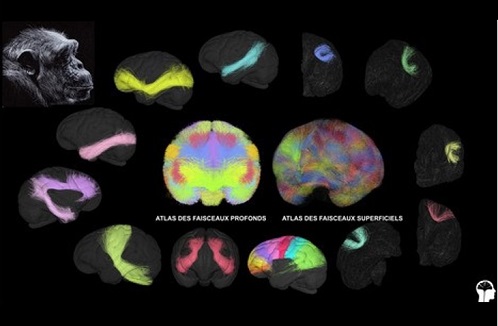Complete mapping of the brain's white matter fiber bundle connections (the structural connectome) is essential to understand how brain networks function, and how structure is linked to brain function. Comparing the chimpanzee brain connectome with that of man helps us to understand the similarities and differences in primate evolution after the split from their common ancestor some 6 million years ago. In contrast to macaque studies, chimpanzee studies are rarer, generally focusing on the examination of cortical folding and basal ganglia and their common features or differences compared to the human brain. Very few studies have focused on the structural connectivity of the chimpanzee brain, as very little diffusion MRI data has been acquired on this protected species.
In this work, researchers established a new atlas of deep and superficial white matter bundles in chimpanzees based on diffusion MRI data acquired up to 2012 on a 3 Tesla MRI system by the american William D. Hopkins team in 39 chimpanzees. The data were processed using a novel fiber grouping pipeline adapted to the chimpanzee brain, enabling the authors to create two atlases of its deep and superficial brain connectivity. These open-access atlases finally provide the scientific community with the reference data it needs to understand the similarities and differences in structural connectivity between human and chimpanzee brains.

Illustration of the atlases of the long (left) and superficial (right) bundles of the chimpanzee brain. © Cyril Poupon / CEA
Thanks to these new atlases, researchers from the french and american teams are now continuing their collaboration to find out whether the differences in connectivity observed between humans and chimpanzees are correlated with behavioral differences between the two species. These atlases will ultimately contribute to a better understanding of the hominid brain evolution.
Contact : Cyril Poupon (cyril.poupon@cea.fr)
This work was carried out as part of the Blaise Pascal Chair at the Université Paris-Saclay, awarded in 2018 to the american primatologist William Hopkins (University of Texas, MD Anderson Cancer Center, USA). The fruit of a successful collaboration initiated in 2010, the Chair has led to several comparative studies to identify phylogenetic similarities and differences between the brains of humans and great apes. Particular attention was paid to i) cortical folding, using anatomical MRI analysis tools developed by Jean-François Mangin's team, and ii) structural connectivity, using diffusion MRI analysis tools developed by Cyril Poupon's team.